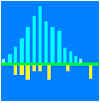Refstat With increased capacity of computers computing intensive statistical methods have become a practical choice for treatment and estimation of data. Holmes et al. (Clin Chem 1994;40:2216-2222) presented a method based on Monte Carlo simulation sampling technique for the verification of reference intervals. Refstat for Windows applies the method suggested by them .Examples of Refstat functions. See here how Refstat - displays the original reference distribution;
example on serum creatinine
Development of software for reference values validation by the Monte Carlo technique Veli Kairisto, University of Turku, Department of Clinical Chemistry, Turku, Finland Allan Poola, ProExpert Ltd., Tallinn, Estonia
Production of reference values is cumbersome and only few laboratories actually produce reference values by themselves. Most clinical laboratories depend on reference limits produced in other laboratories. However, it is customary that the validity of the "borrowed" reference intervals is checked by analyzing a small number of samples from healthy individuals. There is an apparent need for a powerful statistical method to extract as much information as possible from these few samples. With increased capacity of computers computing intensive statistical methods have become a practical choice for treatment and estimation of data. These methods can be applied also for the validation of reference values. Holmes et al. (Clin Chem 1994;40:2216-2222) presented a method based on Monte Carlo sampling technique for the verification of reference intervals. We developed software which applies the method suggested by them. The lowest number of control samples accepted is 7, however, we recommed that at least 20 control samples were examined before attempting the calculations. Our software functions under Microsoft Windows. Data for the program can be imported by standard Windows procedures. The graphical output includes both the reference distribution and the distribution of the control samples in a double histogram display. The Monte Carlo sampling based distributions of the test statistics are also displayed in the graph. As numerical output the program produces probability values for the null hypothesis that the control samples are nothing more than a small sample randomly drawn from the reference distribution. These p-values are calculated for all of the selected test statistics. Probably the greatest practical problem in the application of the method is the poor availability of original sets of reference values. This problem could be solved by the international generation of reference values "banks" that could be accessed via the World Wide Web. |
Refstat
|
